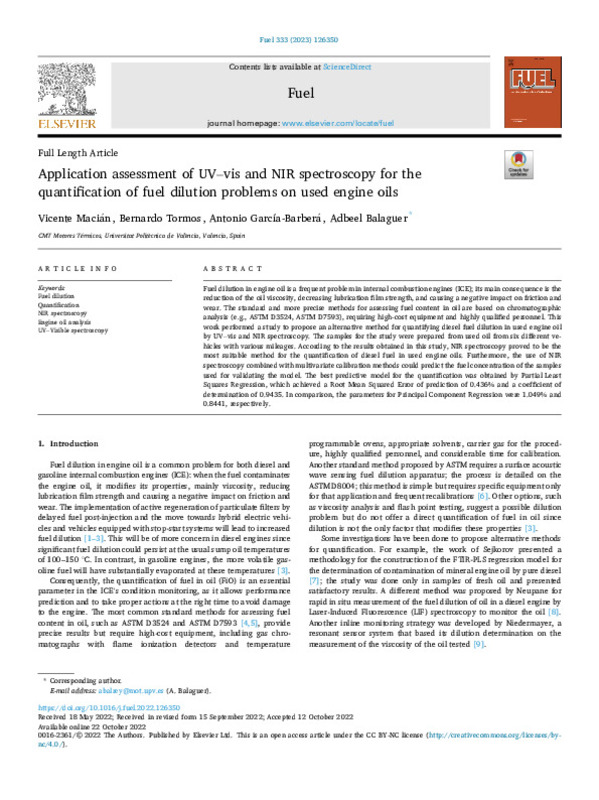JavaScript is disabled for your browser. Some features of this site may not work without it.
Buscar en RiuNet
Listar
Mi cuenta
Estadísticas
Ayuda RiuNet
Admin. UPV
Application assessment of UV-vis and NIR spectroscopy for the quantification of fuel dilution problems on used engine oils
Mostrar el registro sencillo del ítem
Ficheros en el ítem
| dc.contributor.author | Macian Martinez, Vicente
|
es_ES |
| dc.contributor.author | Tormos, B.
|
es_ES |
| dc.contributor.author | García-Barberá, Antonio
|
es_ES |
| dc.contributor.author | Balaguer-Reyes, Adbeel
|
es_ES |
| dc.date.accessioned | 2024-04-11T07:37:57Z | |
| dc.date.available | 2024-04-11T07:37:57Z | |
| dc.date.issued | 2023-02-01 | es_ES |
| dc.identifier.issn | 0016-2361 | es_ES |
| dc.identifier.uri | http://hdl.handle.net/10251/203309 | |
| dc.description.abstract | [EN] Fuel dilution in engine oil is a frequent problem in internal combustion engines (ICE); its main consequence is the reduction of the oil viscosity, decreasing lubrication film strength, and causing a negative impact on friction and wear. The standard and more precise methods for assessing fuel content in oil are based on chromatographic analysis (e.g., ASTM D3524, ASTM D7593), requiring high-cost equipment and highly qualified personnel. This work performed a study to propose an alternative method for quantifying diesel fuel dilution in used engine oil by UV¿vis and NIR spectroscopy. The samples for the study were prepared from used oil from six different vehicles with various mileages. According to the results obtained in this study, NIR spectroscopy proved to be the most suitable method for the quantification of diesel fuel in used engine oils. Furthermore, the use of NIR spectroscopy combined with multivariate calibration methods could predict the fuel concentration of the samples used for validating the model. The best predictive model for the quantification was obtained by Partial Least Squares Regression, which achieved a Root Mean Squared Error of prediction of 0.436% and a coefficient of determination of 0.9435. In comparison, the parameters for Principal Component Regression were 1.049% and 0.8441, respectively. | es_ES |
| dc.description.sponsorship | Acknowledgments This work has been partially supported by grant PID2020-119691RB-100 funded by MCIN/AEI/10.13039/501100011033. | es_ES |
| dc.language | Inglés | es_ES |
| dc.publisher | Elsevier | es_ES |
| dc.relation.ispartof | Fuel | es_ES |
| dc.rights | Reconocimiento - No comercial (by-nc) | es_ES |
| dc.subject | Fuel dilution | es_ES |
| dc.subject | Quantification | es_ES |
| dc.subject | NIR spectroscopy | es_ES |
| dc.subject | Engine oil analysis | es_ES |
| dc.subject | UV-Visible spectroscopy | es_ES |
| dc.subject.classification | MAQUINAS Y MOTORES TERMICOS | es_ES |
| dc.title | Application assessment of UV-vis and NIR spectroscopy for the quantification of fuel dilution problems on used engine oils | es_ES |
| dc.type | Artículo | es_ES |
| dc.identifier.doi | 10.1016/j.fuel.2022.126350 | es_ES |
| dc.relation.projectID | info:eu-repo/grantAgreement/AEI/Plan Estatal de Investigación Científica y Técnica y de Innovación 2017-2020/PID2020-119691RB-I00/ES/MANTENIMIENTO Y CONTROL OPTIMO DE VEHICULOS HIBRIDOS DE TRANSPORTE URBANO MEDIANTE DATOS DEL CONTEXTO OPERACIONAL/ | es_ES |
| dc.rights.accessRights | Abierto | es_ES |
| dc.contributor.affiliation | Universitat Politècnica de València. Escuela Técnica Superior de Ingeniería del Diseño - Escola Tècnica Superior d'Enginyeria del Disseny | es_ES |
| dc.description.bibliographicCitation | Macian Martinez, V.; Tormos, B.; García-Barberá, A.; Balaguer-Reyes, A. (2023). Application assessment of UV-vis and NIR spectroscopy for the quantification of fuel dilution problems on used engine oils. Fuel. 333. https://doi.org/10.1016/j.fuel.2022.126350 | es_ES |
| dc.description.accrualMethod | S | es_ES |
| dc.relation.publisherversion | https://doi.org/10.1016/j.fuel.2022.126350 | es_ES |
| dc.type.version | info:eu-repo/semantics/publishedVersion | es_ES |
| dc.description.volume | 333 | es_ES |
| dc.relation.pasarela | S\483364 | es_ES |
| dc.contributor.funder | AGENCIA ESTATAL DE INVESTIGACION | es_ES |
| dc.contributor.funder | Universitat Politècnica de València | es_ES |








